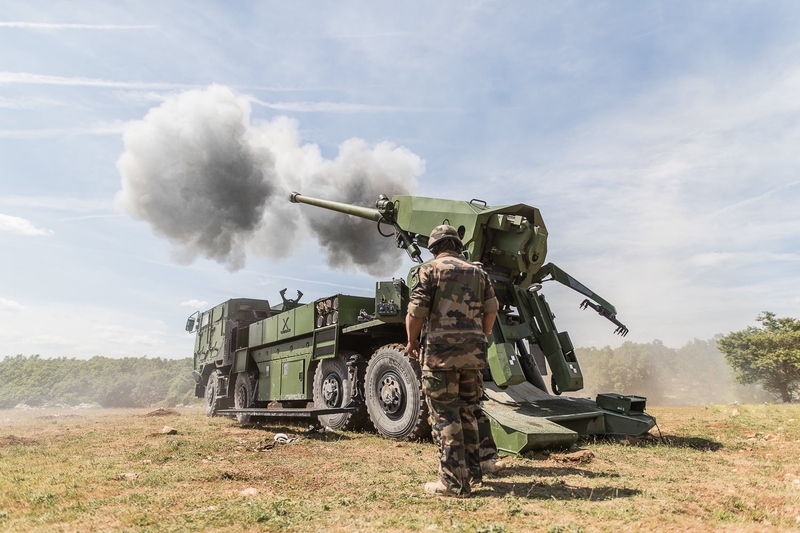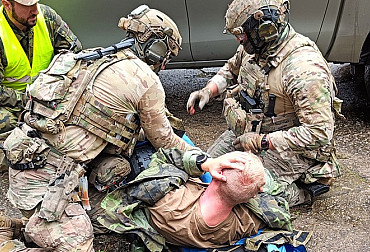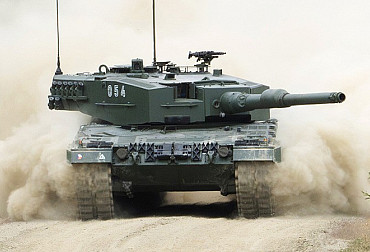Artillery remains the "god of war" or lessons for the Czech Army
The war in Ukraine has been going on for over five months now and has clearly moved into an attrition phase, which is all about the ability to manage and replace one's own losses of manpower and equipment while inflicting the most serious losses on the enemy. It is therefore certainly not surprising that artillery is central to this effort on both sides, as it is again confirmed that it is this component of the military that accounts for the vast majority of casualties in modern conflicts (more than 80% is reported). At the same time, however, the effective deployment of artillery poses a very demanding challenge, as guns and rocket launchers alone form only one component of a complex firing system that also includes, in particular, command, control and intelligence capabilities or logistical support. In layman's terms, it is necessary to ensure that gunners not only have their own weapons, but also good and reliable information on the locations of adversary targets and adequate ammunition supplies. Therefore, the artillery's performance in the war in Ukraine provides lessons for the Czech Army as well.
At the beginning of this conflict, the Ukrainian artillery had almost exclusively weapons that were born in the USSR era. In particular, there were about 1,200 towed and self-propelled howitzers of 122, 152 and 203 mm calibre and about 350 rocket launchers of 122, 220 and 300 mm calibre, along with tactical ballistic missiles of the Tochka series. Ukraine also started several modernisation projects and worked on its own types of artillery weapons and ammunition, but most of them were not successful. Among the few exceptions is the 300 mm Vilcha rocket launcher and missile programme, which has produced a number of guided missiles that have reportedly been used against the Russian army. Ukraine, however, clearly lacked adequate ammunition supplies and its artillery was therefore at a disadvantage compared to the Russian artillery, which could deploy considerably more weapons with large ammunition stocks and also had some more modern types, including Tornado rocket launchers. Ukraine therefore immediately requested assistance from NATO and EU countries. Many of them obliged Kiev, and the Czech Republic quickly joined the ranks of those that started to provide artillery weapons and ammunition.
Thus, for example, supplies of artillery shells and powder charges of 122 and 152 mm calibre and 122 mm unguided rockets were directed to Ukraine, as Czech and Slovak companies still produce these items. Then some specific Czech or Czechoslovak weapons also appeared on the battlefield, in particular ShKH vz. 77 DANA self-propelled howitzers of 152 mm calibre and RM-70 rocket launchers of 122 mm calibre. Both types are closely related in terms of ammunition and basic principles to the weapons already introduced in the Ukrainian army, and therefore their operation did not pose much of a problem, but due to their design specifics (among others, Tatra chassis and loading systems) they are characterized by a higher combat value. The same applies to the two new types of rocket launchers that have appeared in Ukraine. The first is called the RM-70 Vampire 4D and is essentially a new variation of the RM-70, while the second is called the Burevij and was developed as a modification of the Soviet 220 mm calibre Uragan rocket launcher. Both use Tatra Force eight-wheel chassis with armoured cabins and have also received new digital fire control systems.
However, Kiev has also repeatedly requested the delivery of NATO-standard artillery weapons, in particular 155 mm howitzers and 227 mm rocket launchers. Thus, the first M777 towed howitzers were sent during April, self-propelled systems of the same calibre appeared on the battlefield in May, and at the end of June Ukraine received its first 227 mm HIMARS rocket launchers. From the Czech point of view, it is certainly not without interest that the first type of 155mm self-propelled howitzer that Ukraine took over was the CAESAR set from the French arms company Nexter. The Czech Army has also opted for this weapon, although it will be a different variant, as Paris has sent Kiev howitzers from the arsenal of its armed forces, namely on a six-wheeled Renault Sherpa chassis, while the Czech Republic intends to use a variant on an eight-wheeled Tatra Force chassis. This will allow, among other things, the transport of larger ammunition stocks and the Czech version will also have mechanical reloading assistance, but the weapon itself of both variants is identical, as it is a 155mm howitzer with a barrel length of 52 times the calibre, which with the best types of shells reaches a maximum range of around 40 km.

Picture: From the Czech point of view, it is certainly not without interest that the first type of 155mm self-propelled howitzer that Ukraine took over was the CAESAR kit from the French arms company Nexter. (illustration photo) | NEXTER Systems
This impressive range was one of the main reasons why CAESAR kits quickly gained great respect and popularity in Ukraine. In practice, this means that they can "out-shoot" Russian weapons, so to speak, because the standard 152mm howitzers in the Russian army, which are the Msta series weapons (specifically the towed Msta-B and self-propelled Msta-S), offer a range of only about 25 km, and 29 km using grenades with additional rocket motors. The CAESAR howitzers and other Western systems with 52-gun barrels (such as the Polish AHS Krab and German PzH 2000) also enjoy an advantage against the Russian Giacint series howitzers (namely the towed Giacint-B and self-propelled Giacint-S), which have a maximum range of just over 33 km. Another great advantage of modern NATO weapons is their ability to fire "smart" grenades, including M982 Excalibur ammunition with satellite guidance or grenades containing a self-guided submunition against tanks (such as BONUS or SMArt grenades). The howitzers thus gain the ability to conduct very accurate fire against significant point targets.
In addition to firepower in the narrower sense, the CAESAR self-propelled howitzer has also won praise for its high mobility and flexibility. In just one minute it can take up a position, fire six shells in another minute, and leave the position again in another minute, thus avoiding retaliatory enemy fire. This capability, commonly referred to as "shoot and scoot", is now considered extremely important in artillery systems. It is worth noting at this point that the CAESAR system has so convincingly refuted the criticism that has sometimes been levelled at it. The criticism has been that the French developed it primarily for operations against a less advanced enemy, and that its experience in Afghanistan, Iraq and Mali is consistent with this. According to the critics, the CAESAR is (allegedly) not suitable for a classic interstate war, in which it would (allegedly) be very vulnerable, among other things because it (allegedly) does not provide enough protection for the operator, who has to load the weapon manually. The reality of the conflict in Ukraine, however, shows the opposite, as the Ukrainian CAESAR howitzers perform excellently against the Russian army. They first arrived on the battlefield at the end of May and since then none are known to have been destroyed or damaged.
The choice of the CAESAR howitzer for the Czech Army can therefore be considered the right move in light of the real experience in Ukraine, as it offers an excellent combination of firepower, mobility and flexibility. This will be all the more true for the Tatra chassis version, which will have a larger ammunition supply and a partially mechanised reloading assist, which should allow for even higher rates of fire. It may also be recalled that CAESAR offers the MRSI (Multiple Round Simultaneous Impact) mode, which uses a system of modular powder charges to achieve a wide range of impact velocities. The howitzer can therefore fire a sequence of rounds with a gradually decreasing angle of aim and increasing impact velocity, so that all the rounds fired in this way will hit the target virtually simultaneously. In any case, in a general sense it is confirmed (and this is also shown by the efforts of Ukraine itself) that the transition to the Allied 155 mm artillery standard is correct in all respects, as it means a really significant increase in the real combat value of artillery.
After all, the two new types of artillery weapons of Czech origin also correspond to this. In 2021, a demonstrator of the 155mm self-propelled howitzer DITA, which follows the design philosophy of the famous DANA weapon, was presented to the public. It uses an eight-wheeled chassis with a low cab and engine at the rear and a centrally mounted turret, which houses a new 155 mm calibre gun with a barrel length of 45 times the calibre. The DITA has only a two-man crew in the cab as standard, although the turret houses a gunner's station for emergency situations. Then this June, another new type called the Morana was introduced, which uses a Tatra Force chassis with an armoured cab and engine in the middle, while the turret is rear-mounted. This time it contains a 155mm gun with a barrel length of 52 times the calibre, and the crew numbers three men in the cab as standard, although the cab can accommodate a fourth man and the turret again houses the emergency sighting position. Of course, both the DITA and Morana types have automatic reloading, which also follows the famous DANA howitzer, which was the first mass-produced self-propelled howitzer with this feature.
The new variant of the CAESAR howitzer as well as the Czech DITA and Morana systems use the Tatra eight-wheel chassis and 155 mm calibre guns, and are therefore in all cases representatives of the TMG (Truck Mounted Gun) category. At the same time, however, they represent three different design approaches, since in the case of the CAESAR system the howitzer itself is mounted on the rear of a car chassis without a turret and relies on manual loading with mechanical assistance, whereas the DITA and Morana systems rely on massive armoured turrets with automatic loading machines. At the same time, however, they clearly differ in the way these turrets are assembled and the level of automation, or the number of crew members. The customer can therefore choose between different solutions according to what optimally suits his needs and requirements. Tatra chassis always mean a superior level of mobility on the road and in the field, although the gun turrets of the DITA and Morana complexes can be mounted on other wheeled or tracked chassis platforms if desired.
Of course, in the context of the war in Ukraine, mention should also be made of artillery rocket launchers, which have gained considerable attention from the general public, who can follow the impressive achievements of the 227 mm calibre M142 HIMARS complexes. Of course, the Ukrainian army also continues to deploy weapons of Soviet calibre, i.e. 122, 220 and 300 mm, although in addition to the original types of rocket launchers and missiles of Soviet origin, it also has more advanced types. In the 122 mm calibre these are the aforementioned Czech and Czechoslovak RM-70 and RM-70 Vampire 4D sets, while in the 220 mm calibre they are the Burevij type on a Tatra chassis and in the 300 mm calibre they are Vilcha guided missiles. (One might also add that the final form of the Vilcha missile launcher might also go on a Tatra chassis.) However, the extraordinary importance of rocket launchers on the modern battlefield, which the conflict in Ukraine clearly reaffirms, is sadly contrasted by the fact that the Czech Army scrapped this type of weapon in 2010 without replacement when it retired the RM-70 systems. Logically, there is a strong call for the reintroduction of rocket launchers.
A hint of it can be found in the Concept of the Construction of the Army of the Czech Republic 2025, which was written in 2015. At that time, it was probably a response to the extensive deployment of rocket launchers during the fighting in the Donbas. However, the updated Concept of Build-up of the Army of the Czech Republic 2030, which was written in 2019, no longer mentions rocket launchers. However, it is very likely that rocket launchers will reappear in the current reflections on the future of the Czech Army, especially, of course, under the influence of the Russian-Ukrainian war. Should the demand arise on the part of the Army of the Czech Republic to restore this capability at least in its basic form as soon as possible, then the option of introducing 122mm RM-70 Vampire 4D rocket launchers, which are available almost immediately, is offered. The 122mm calibre is not a NATO standard, but it is still widespread in the region and a number of manufacturers are supplying much more advanced types of missile. Recall that the basic 122mm missiles offer a maximum range of around 20 km, but there are already missiles with a range of around 40 km, or types equipped with terminal satellite guidance or cluster missiles with various types of submunitions.
Given the success of the M142 HIMARS missile launchers in Ukraine, it is certainly not surprising that the idea of including this weapon in the arsenal of the Czech army soon emerged. The 227 mm calibre represents the Alliance standard, as HIMARS rocket launchers or M270 MLRS tracked systems are already operated or will soon be operated by a number of NATO and EU members, including countries in the Central European region, such as Germany, Romania, Poland and Estonia. Slovakia should not be forgotten either, as its army owns the remarkable RM-70 Modular missile launcher on a Tatra chassis, which is capable of using both 122 and 227 mm calibre missiles thanks to its modular concept. Another alternative could be Israeli modular rocket launchers such as the IMI Lynx or Elbit PULS, which can launch not only a wide range of different unguided missiles, but even tactical ballistic missiles. The latter is also handled by HIMARS, which can launch ATACMS missiles with a range of up to 300 km. Anyway, it should be true that any new artillery rocket launchers for the Czech Army should use Tatra chassis, which are standard in the Czech army, so it would not be desirable to introduce a completely different platform.
In addition to the howitzers and rocket launchers themselves, care should undoubtedly be taken to ensure an adequate supply of ammunition, because the war in Ukraine convincingly demonstrates the huge consumption of shells and rockets that modern artillery can have. In the Czech Republic (fortunately) there are several companies that can supply artillery shells, powder charges or rockets of various calibers, even in NATO standards. Many of them actually do, as unofficial sources make it clear that the Ukrainian army has been taking and using artillery ammunition of various calibers from the Czech Republic and Slovakia for several months now. Legally, these are not numbers that could compete with, for example, supplies from the US, but even so, they are undeniably valuable contributions. Moreover, the "old" NATO members, of course, supply only 155 mm calibre shells, whereas only the former Eastern Bloc countries (apart from the Czech Republic and Slovakia, also Poland and Bulgaria) supply ammunition of "Eastern" calibres. In this sense, the production capacities of Czech armaments factories represent an extremely important contribution to the Ukrainian war effort.
In conclusion, the war in Ukraine has clearly demonstrated the continued importance and value of artillery for the conduct of large-scale military operations. It also confirmed the superiority of Western 155mm howitzers over 152mm weapons of the Soviet design school, especially in terms of range, accuracy, or the ability to use "smart" ammunition. The French CAESAR howitzers, for example, performed very well, disproving former doubts about the suitability of their design for large-scale interstate warfare. Thus, the Czech Army made the right choice in opting for the CAESAR type, although this does not, of course, preclude the introduction of a heavier system in the future, the concepts of which are demonstrated, for example, by the new DITA and Morana types. The enormous effectiveness of rocket launchers has also been demonstrated, so the Czech Army should again consider their introduction. Last but not least, the huge consumption of grenades and powder charges has also been demonstrated, and it is therefore necessary to ensure that Czech artillery weapons always have adequate ammunition supplies.





















